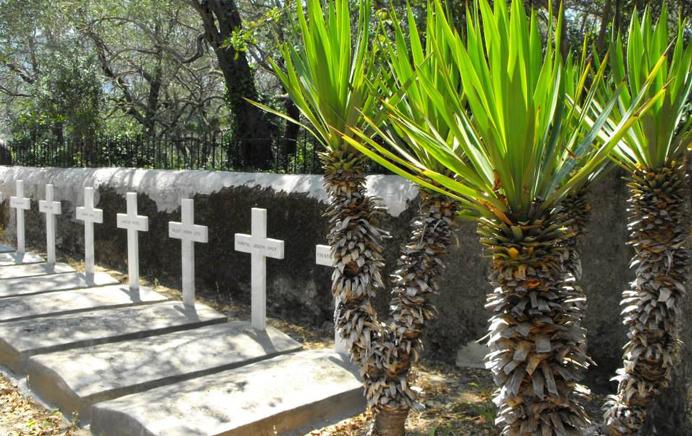French military graves on the island of Corfu

Cimetière militaire français de Gastouri (Corfou).
DR
The Western Front may have been the main theatre of operations in the First World War, but the fighting was by no means limited to that area. Very early on, the stalemate in both east and west led the Entente Powers to try to secure a decisive victory by means of peripheral operations. To that end, sizeable expeditionary forces were mobilised against the Central Powers – first the Turks, then the Bulgarians – in the Dardanelles and the Balkans. The Eastern Front thus rapidly became one of the major fronts of the First World War.
In 1915, the failure of the Dardanelles expedition meant the Franco-British forces had to retreat to Salonika (present-day Thessaloniki), which they transformed into a veritable fortress, equipped with fortifications and military hospitals. The operation proved quite difficult, since what little civilian and military infrastructure there was was ill-suited to the arrival of 400 000 troops (150 000 of them French Army).
In January 1916, the Serbian Army was defeated by the Austro-Hungarians. Part of the troops managed to get away by sea from the Albanian coast and found refuge nearby, on the Greek island of Corfu, which had recently come under French control. After regrouping and being re-equipped by the French, 125 000 Serbs would go on to take part in the victorious offensives of 1918, before the armistice, signed at Salonika on 29 September 1918, put an end to the conflict on the Eastern Front.
During the war, Corfu rapidly became an important base for the Army of the Orient.
In fact, the large numbers of sick caused the military authorities to establish a medical team on the island, requisitioning part of the grounds of the Achilleion, the former palace of Empress Elisabeth of Austria, and transforming the palace itself into a military hospital for French and Serbian soldiers. The wounded and the sick died in their dozens every day, either as a result of their wounds or of dysentery, which was rife among the soldiers.
The dead were buried in a small cemetery in nearby Gastouri, set in a pine forest on a hillside 20 minutes from the centre of Corfu. A narrow lane brings visitors to the cemetery’s entrance. At the back on the right, a small set of steps leads up to a calvary, consisting of a large cross, a place of remembrance.
Two hundred and nine French soldiers are buried on this site. Their graves come under the responsibility of the Ministry of the Armed Forces Directorate for Heritage, Remembrance and Archives (DPMA), which allocates funding annually to the French diplomatic post in Greece for the preservation of the site.
A total of 8 663 French graves are catalogued in Greece, in six military cemeteries. The soldiers buried there were killed in the Crimean War (1853-56), the Crete War of Independence (1886) or the First World War.

